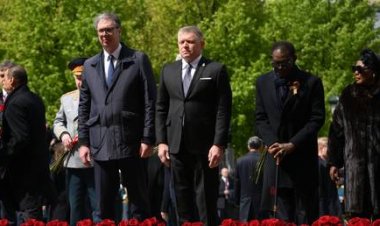Echoes of Jan. 6 committee as Jack Smith foreshadows plan to tie Trump to Capitol riot
Donald Trump doesn’t want prosecutors to talk about Jan. 6. They want to make it central to their case.


When Donald Trump faces a jury on charges stemming from his bid to subvert the 2020 election, he wants to prohibit federal prosecutors from even mentioning the chaos and violence unleashed by his supporters at the Capitol on Jan. 6, 2021. But to special counsel Jack Smith, Trump’s role in the riot is the heart of the case.
A new court filing from Smith’s team this week reveals that the mob that stormed Congress in Trump’s name will be the centerpiece of his trial, scheduled to begin on March 4. It wasn’t just an unfortunate reaction to Trump’s incendiary remarks that day, prosecutors contend. It was a tool that Trump used to launch one last desperate bid to cling to power.
Trump’s criminal conspiracies “culminated and converged” on Jan. 6, when he attempted to prevent Congress from finalizing Joe Biden’s victory, argued senior assistant special counsel Molly Gaston.
“One of the ways that the defendant did so … was to direct an angry crowd of his supporters to the Capitol and to continue to stoke their anger while they were rioting,” Gaston wrote in the filing.
In a way, Smith is now casting Trump’s trial as a long-awaited collision between two distinct narratives: Trump’s monthslong campaign to use lies about election fraud to pressure state and federal election officials to keep him in power; and the rioters who embraced Trump’s false claims and took violent action on his behalf on Jan. 6. Those investigations have largely moved along separate tracks in the Washington courts, where a revolving door of Jan. 6 riot defendants have faced punishment while Smith’s grand jury, just a few paces down the hall, worked secretly on the Trump probe.
Smith introduced the indictment to America on Aug. 1 with a reference to the riot, calling it “an unprecedented assault on the seat of American democracy” that was “fueled by lies.” But until this week, it remained unclear whether the harrowing attack would merely be mood music for a trial focused on Trump and his rarefied inner circle, or whether the riot would be inextricably linked to the case. In fact, in Trump’s bid to strike the riot references from his indictment — as well as in a bid to shelve a gag order — he cited Smith’s comments as an irrelevant offshoot from the case against him.
By combining the Trump allegations with the riot, Smith is unlocking a mountain of case law developed in those Jan. 6 riot cases to tie Trump more clearly to the violence than he has been to date. In short, he’s casting Trump as one of the 1,200-plus riot defendants who have already been charged.
“[T]he defendant here is charged with four related criminal counts, including conspiring to obstruct and obstructing the official certification proceeding on January 6,” Gaston wrote. “Essential to those charges are factual allegations and evidence that the proceeding was in fact impeded — namely, by a large crowd, including individuals whom the defendant had directed at the Capitol, that violently advanced on the Capitol building to create ‘a catastrophic security risk.’”

Smith’s strategy to knit the streams of evidence together is a natural outgrowth of the investigation but also a risky one. Judges in Washington have noted that Trump didn’t explicitly tell his supporters to breach barricades, commit violence or break other laws, and they’ve held repeatedly that defendants who sought to blame Trump for their illegal conduct were responsible for their own actions. Trump is not charged with inciting the riot, and he’s currently fighting legal battles over whether he’s immune from civil lawsuits related to remarks that day.
Yet the argument that Trump bears responsibility for causing and exploiting the riot is also familiar; it harkens directly to the one made by the House Jan. 6 select committee in its public hearings and report. Trump didn’t just assemble and stoke the violent mob that day, the panel argued; he used it to keep pressure on lawmakers and then-Vice President Mike Pence to further derail the day’s constitutionally mandated proceedings.
Jan. 6 committee veterans say the echoes of their case are both a necessary part of the story for prosecutors to tell and a validation of their work.
“They’re going to adopt the very same factual theory here and tell the same story that we did, that [the riot] is the logical last step of an increasingly desperate conspiracy,” Tim Heaphy, the former chief investigative counsel for the select committee, said in a phone interview.
The words in Smith’s filing are almost verbatim the case that the committee’s vice chair, Liz Cheney, made at the panel’s first public hearing. And another committee veteran, Thomas Joscelyn, the lead author of the panel’s final report, said Smith had “rightly concluded that January 6th was the ‘culmination’ of then President Trump’s attempt to overturn the legitimate results of the 2020 presidential election.”
To make that case, Smith seems poised to adopt another tactic the select committee once used: testimony of the Jan. 6 rioters themselves, along with video of the mob’s intense violence — much of it coming after Trump repeatedly implored his supporters to march on the Capitol. Gaston indicated that prosecutors intend to “prove these allegations with evidence that the defendant’s supporters took obstructive actions at the Capitol at the defendant’s direction and on his behalf.”
Among the evidence, Gaston says, will be “testimony, video, photographic, and geolocation” data showing that rioters responded to Trump’s call to march on the Capitol, as well as similar evidence that those who heard Trump tell them to “fight” later engaged in violent confrontations with police.
Prosecutors, of course, have an extraordinary wealth of such evidence at their disposal. Dozens — if not hundreds — of those charged in the riot have pointed squarely at Trump for motivating their conduct. Thousands of Trump’s supporters had already begun marching to the Capitol before Trump urged them to conduct their march “peacefully and patriotically.”
Among the defendants whom prosecutors may call to the stand are rioters like Dustin Thompson, who argued unsuccessfully at trial that his decision to maraud through the Senate parliamentarian’s office amid the chaos was a direct result of Trump’s remarks. Danny Rodriguez, who buried a borrowed taser into the neck of D.C. Police Officer Michael Fanone on Jan. 6, has similarly argued that he was essentially brainwashed by Trump’s lies about election fraud.
The Jan. 6 committee used public testimony from defendant Stephen Ayres, and video statements from others, to underscore a similar point.
Smith also intends to show that Trump was fully knowledgeable of the violence underway at the Capitol — and the threat to lawmakers and Pence — when he refused entreaties to calm the crowd and instead inflamed them further by tweeting that Pence “didn’t have the courage” to block Biden’s election. He instead used the delays caused by the mob to continue leaning on members of Congress to lodge objections to the election results and buy more time to stave off Biden’s victory.
Smith’s description of the case he plans to lay out was a response to Trump’s demand that U.S. District Court Judge Tanya Chutkan strike references to the Jan. 6 riot from the language of the indictment. He argued that the charges against him aren’t related to the riot and the references to the attack were inflammatory “surplusage” intended to stir the passions of prospective jurors.
“Because the Government has not charged President Trump with responsibility for the actions at the Capitol on January 6, 2021, allegations related to these actions are not relevant and are prejudicial and inflammatory,” Trump’s attorney John Lauro argued last week.
To counter that contention, Smith borrowed from the numerous rulings judges have made in Jan. 6 riot cases, finding that it’s important for prosecutors to describe the violence and chaos of the riot, even in the cases of defendants who didn’t participate in the most egregious acts.
“[G]eneral evidence about the events on January 6 — even if defendant did not personally observe all of the conduct engaged in by others in multiple parts of the Capitol Building and restricted grounds — assists the jury in better understanding the parties’ actions that day and thus the alleged criminal conduct of defendant,” U.S. District Court Judge Beryl Howell ruled on May 8, in an opinion cited by prosecutors.
Trump has argued in civil lawsuits and other filings that he was using common political metaphors when he urged the crowd to “fight like hell” to prevent Biden from taking office. The Jan. 6 committee presented evidence that Trump was aware of the presence of weapons in the crowd he addressed and that he sought to travel with the crowd to the Capitol, only to be overruled by the Secret Service.












